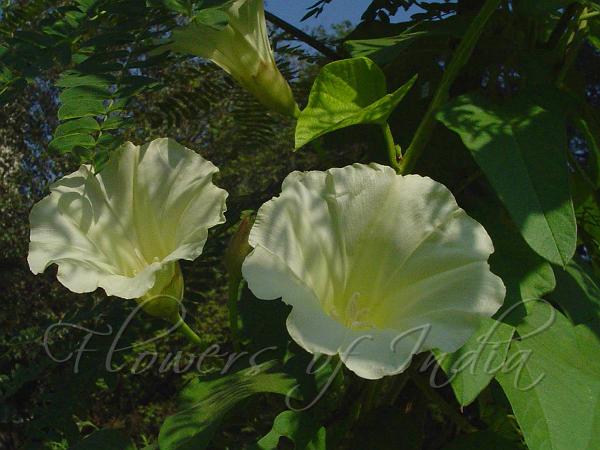|
| Transparent Wood Rose |
|

|

|
|
|
|
Photo: |
Botanical name: Operculina turpethum Family: Convolvulaceae (Morning glory family)
Synonyms: Merremia turpethum, Ipomoea turpethum
Synonyms: Merremia turpethum, Ipomoea turpethum
Transparent Wood Rose is a herbaceous, somewhat hairy vine reaching a
length of 5 meters or more. The stems are often purplish, prominently 2- to
4- angled, and narrowly winged. The leaves are entire, ovate, 5-15 cm long,
narrowing to a pointed tip, and broad, somewhat heart-shaped, or straight
at the base. The inflorescences (cymes) have few straight flowers and are
borne in the axils of the leaves. The sepals are green, and ovate to
oblong-ovate; the outer two, 2-3 cm long, are larger than the inner three,
and hairy, somewhat fleshy, and usually purplish on the fruit. The corolla
is white, bell-shaped, and about 4 cm long, with the limb 4 cm wide. The
transluscent capsules are rounded, being 1-1.5 cm in diameter, and contain normally 4
black, smooth seeds. Transparent Wood Rose is found in Somalia to S. Tropical
Africa, W. Indian Ocean, Tropical & Subtropical Asia to Pacific. It is also
found in East Himalaya at altitudes of 600 m.
Medicinal uses: In the Philippines the root, either pulverized
or in alcoholic tincture, is employed as a drastic purgative. The dried and
powdered root-bark is considered cathartic and laxative, resembling jalap
in its action. It is a drastic purgative of phlegmatic humors and bile.
With ginger, it is particularly beneficial in rheumatic and paralytic
affections. In India the fresh bark of the root is rubbed with milk and
employed as a purgative.
In the Philippines the root, either pulverized
or in alcoholic tincture, is employed as a drastic purgative. The dried and
powdered root-bark is considered cathartic and laxative, resembling jalap
in its action. It is a drastic purgative of phlegmatic humors and bile.
With ginger, it is particularly beneficial in rheumatic and paralytic
affections. In India the fresh bark of the root is rubbed with milk and
employed as a purgative.
Medicinal uses:
 In the Philippines the root, either pulverized
or in alcoholic tincture, is employed as a drastic purgative. The dried and
powdered root-bark is considered cathartic and laxative, resembling jalap
in its action. It is a drastic purgative of phlegmatic humors and bile.
With ginger, it is particularly beneficial in rheumatic and paralytic
affections. In India the fresh bark of the root is rubbed with milk and
employed as a purgative.
In the Philippines the root, either pulverized
or in alcoholic tincture, is employed as a drastic purgative. The dried and
powdered root-bark is considered cathartic and laxative, resembling jalap
in its action. It is a drastic purgative of phlegmatic humors and bile.
With ginger, it is particularly beneficial in rheumatic and paralytic
affections. In India the fresh bark of the root is rubbed with milk and
employed as a purgative. | Identification credit: Prashant Awale | Photographed at Chembur, Mumbai & Dalam sanctuary, Jharkhand. |
• Is this flower misidentified? If yes,